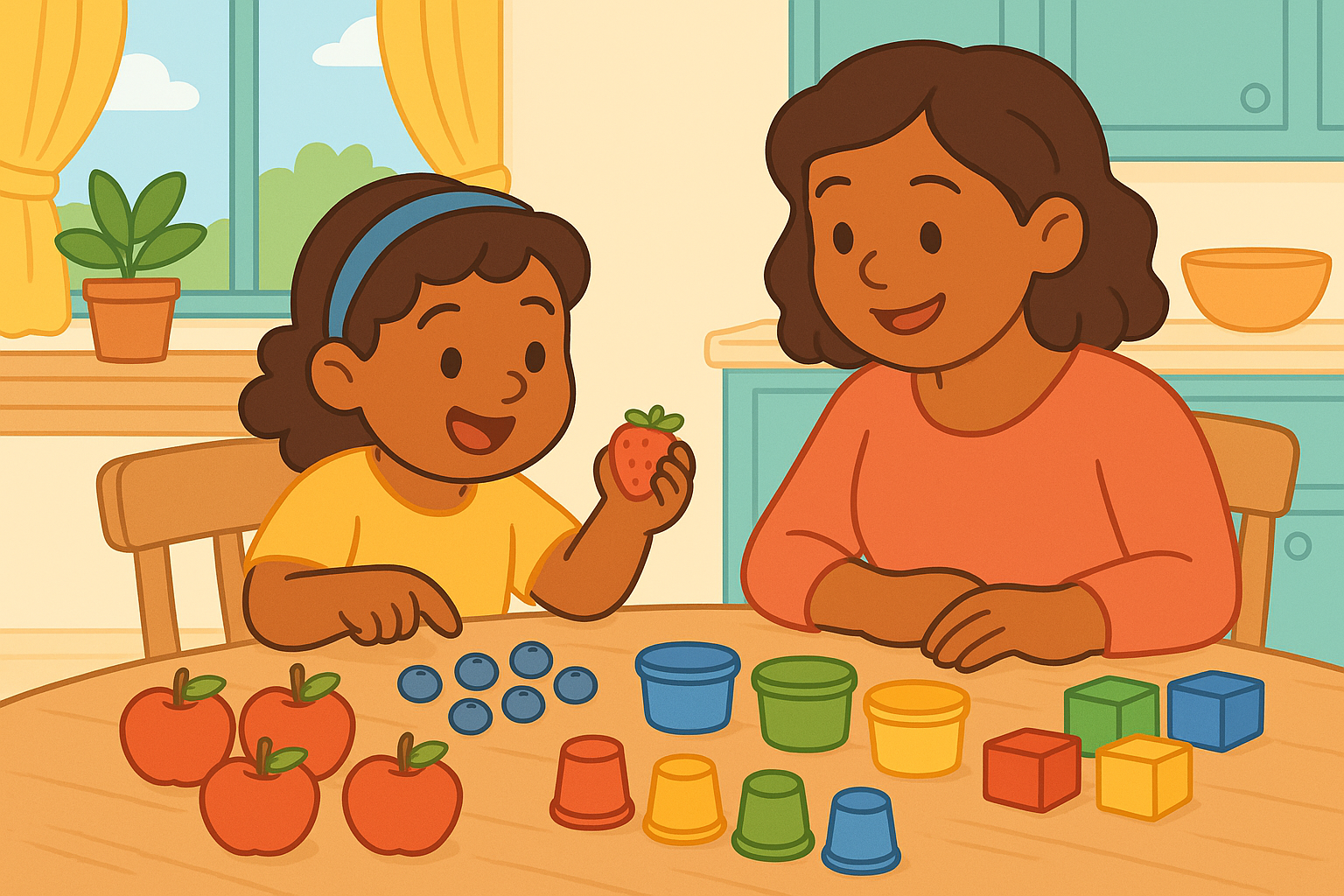Teaching Early Math Concepts with Everyday Objects
Teaching Early Math Concepts with Everyday Objects
Math Starts at the Kitchen Table
You don’t need flashcards, fancy manipulatives, or a classroom to teach math — you just need a curious child and the objects around you.
From sorting laundry to stacking cups, early math happens naturally when children play, explore, and compare the world around them.
What Early Math Really Looks Like
Preschool math begins long before kids learn to count on paper. It’s about noticing relationships and patterns in the world around them.
Here are the five core foundations of early math that naturally emerge through everyday play:
When you use simple, everyday objects to explore these ideas, you’re teaching your child to see math everywhere.
Related article:
Everyday Math Moments: Counting, Sorting, Comparing →
Learn how to turn everyday routines into joyful math play.
Why Hands-On Math Builds Lasting Skills
Children learn best when they can touch, see, and move objects. When math is concrete, not abstract, it builds meaning.
For example:
🧩 When they line up crayons and count each one, they’re understanding quantity.
🍎 When they share snacks equally, they’re exploring division.
🪣 When they pour water between cups, they’re discovering volume.
“The earlier math feels real, the easier it becomes later.”
Related reading:
Early STEM at Home: Simple Science Projects for Ages 3–6 →
Explore how hands-on exploration strengthens problem-solving and reasoning.
10 Everyday Object Activities That Teach Math Naturally
These simple, play-based activities build powerful early math concepts — using only what you already have at home.
1. Sock Sort & Match
Gather clean laundry and invite your child to match socks by color, pattern, or size.
Ask questions:
“Which one is longer?”
“Can we find another pair that looks the same?”
Skill: Sorting, matching, comparing
Related reading:
Sensory Bins That Teach Sorting and Classifying →
Discover how sorting builds organization and logic in early learners.
2. Snack Counting
At snack time, count pieces of cereal, crackers, or fruit. Encourage your child to share evenly between plates or cups.
“If we have 10 grapes and share them, how many do we each get?”
Skill: Counting, dividing, one-to-one correspondence
3. Toy Graphing
Lay out toys and graph them by type or color — cars, blocks, animals. Use sticky notes or paper to represent each group.
Ask:
“Which has more?”
“Which has fewer?”
Skill: Data comparison, visual reasoning
4. Measuring with Household Items
Skip the ruler — grab spoons, books, or string! Measure the couch or table in “spoon lengths” or “book widths.”
Skill: Measurement, estimation, spatial awareness
5. Shape Hunt
Go on a “shape safari” around your home.
“I spy something round!”
“Can you find something shaped like a triangle?”
Use objects like clocks, doors, and pillows to make it concrete.
Skill: Geometry, observation
Related reading:
Teaching Colors and Shapes Through Play →
See how playful discovery builds vocabulary and visual recognition.
6. Cup Stacking Challenge
Give your child paper cups or blocks to stack into towers. Count how many cups tall it gets before tipping.
Ask:
“What can we do to make it taller next time?”
Skill: Counting, patterning, spatial reasoning
7. Kitchen Measurement Play
While cooking, let your child measure ingredients using spoons or cups.
“We need one cup of flour — let’s scoop together!”
“How many scoops make one cup?”
Skill: Fractions, quantities, estimation
Related article:
Helping Kids Build Focus Through Playful Routines →
Explore how shared routines improve concentration and cooperation.
8. Pattern Necklace Craft
Use beads, pasta, or cereal to make simple color patterns: red–blue–red–blue, or circle–square–circle–square.
Ask your child to predict what comes next or create their own pattern.
Skill: Pattern recognition, sequencing, fine motor coordination
Related article:
Games That Teach Pattern Recognition and Memory →
See how playful patterning builds attention and recall.
9. Number Line Hop
Tape numbers 1–10 on the floor. Have your child hop to each number as you call it out — or hop forward/backward by counting.
Skill: Number order, sequencing, gross motor coordination
10. Cleanup Countdown
Turn cleanup into a math game!
“Let’s pick up five toys together — 1, 2, 3…”
“Can we beat our time from yesterday?”
Skill: Counting, time awareness, motivation through movement
Everyday Math in Conversation
Talk about math naturally throughout the day.
“Which bowl is bigger?”
“How many blocks are in your tower?”
“Can we find two things that are the same size?”
When math feels like conversation, kids start seeing it as part of daily life — not just “schoolwork.”
Related reading:
The Importance of Open-Ended Questions in Learning →
Learn how thoughtful questioning helps children explore and reason deeply.
Tips for Parents
Follow their lead. Use their favorite toys or snacks as math tools.
Keep it playful. Focus on discovery, not perfection.
Use comparison words. Bigger, smaller, heavier, longer — vocabulary builds comprehension.
Celebrate curiosity. Every “why” or “what if” question is a math moment in disguise.
This content is for educational purposes and is not a substitute for professional medical or psychological advice.
Popular Parenting Articles





